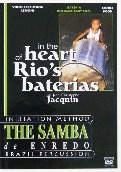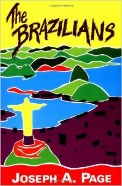Carnaval — known as “Carnival” in English — is a popular festivity that has roots in the pre-Christian rituals of the ancient Greeks and Romans. Incorporated into the Catholic calendar as officially four days of celebration before the more pious period of Lent, Carnaval is held in many countries with Catholic roots and is known in New Orleans as “Mardi Gras” (meaning “Fat Tuesday,” the day before Ash Wednesday, the start of Lent).
Carnaval is celebrated all over Brazil, and today, Brazil is home to a few of the most famous Carnaval parties on Earth, especially in Salvador, Bahia; Recife and Olinda, Pernambuco; and the biggest of all, Rio de Janeiro. Synthesizing European, African, and indigenous traditions in various combinations, Brazilian Carnaval owes a tremendous amount to the country’s rich African heritage.
The earliest form of Carnaval in Rio, the Portuguese entrudo, consisted of people going out onto the streets and throwing flour balls, dirty water, and suspect liquids at each other. In the 1840s and 1850s, the entrudo gave way to other more “refined” forms of celebration, including European-style masked balls and competitive parades with floats sponsored by associations called grandes sociedades (great societies).
The Afro-Brazilian presence in Carnaval intensified in the latter half of the 1800s, represented by informal groups called cordões and blocos, as well as more organized contingents known as ranchos, which pioneered the use of themes.
First appearing in the late 1920s, Rio’s most famous Carnaval tradition, the samba schools, comprise a synthesis of the various types of elite and popular groups that preceded them. Based mostly in Rio’s poor neighborhoods and with origins in Afro-Brazilian culture, the samba schools function as social clubs and community centers that often provide assistance and job opportunities to their constituencies, while disseminating the samba through the generations. Over the decades, the escolas have emerged as the centerpiece of Rio’s Carnaval. They have become a major tourist attraction and an enduring global emblem of what it means to be Brazilian.
Since the 1960s, the samba schools have come under the increasing influence of the City’s middle and upper classes and of outside leaders, patrons, and sponsors. Today’s samba school parades are a monumental event that takes place every Carnaval in a specially-built stadium called the Sambódromo, attracting more than 70,000 spectators with many more watching the live TV broadcast worldwide.
Even with their massive popularity, Rio’s escolas have remained an essential expression of their core communities. These communities spend an entire year constructing floats and costumes, honing their dance steps and baterias (percussion sections), composing and rehearsing original samba songs, and coordinating among thousands of participants to produce a spectacle of artistic excellence that unites people of various races and backgrounds, bringing joy and inspiration to people all across the planet.
Look

source Joãozinho Trinta (João Clemente Jorge Trinta, 1933-2011), second from left, was one of the most innovative carnavalescos (art directors) in the history of the Rio Carnaval.

sourceMestre Jonas de Oliveira is a renowned samba percussion master from Rio who has led the baterias of some of the City’s top samba schools and trained numerous samba groups throughout Europe and the UK. Seen here at Rio’s Acadêmicos do Cubango Samba School. PHOTO BY DOUG MENUEZ.
Watch
Unidos da Tijuca 2014. The parade of the champion
samba school of the 2014 Rio Carnaval.
Acadêmicos do Salgueiro Samba School Rehearsal in the Sambódromo 2012.

Dudu Nobre: Os Mais Lindos Sambas-Enredo de Todos os Tempos (DVD)
A live performance of classic samba-enredo by one of Rio’s current samba stars.

In the Heart of Rio’s Baterias with Jean-Christophe Jacquin (DVD)
A pioneering DVD package that includes a documentary on Rio’s baterias and a video course on samba percussion taught by one of Europe’s most noted samba teachers.
Samba New York! – Bateria 101
An introduction to the some of the basic instruments and rhythms of the bateria by one of the top samba schools in the U.S.
Samba New York! – Bateria 102
A continuation of “Bateria 101” that explores the samba-enredo song form.
Samba Master Class
An innovative website offering online instruction in samba school, pagode (small-group samba), Candomblé, and other Afro-Brazilian folkloric percussion by Jorge Alabê and Michael Spiro, two leading performer-educators of Brazilian music in the U.S. From Rio, Jorge Alabê is one of the foremost samba and Candomblé master drummers living outside of Brazil. Visit Webite.
Read

Samba
A riveting account of the author’s experience living in the Mangueira favela (shantytown slum) and parading with the Mangueira Samba School in the late 1980s.

The Brazilian Sound
One of the most comprehensive books on Brazilian popular music in English with an excellent chapter on samba.

The Brazilians
A well-written and intriguing exploration of the Brazilian people approached from a variety of perspectives including race, class, violence, religion, sports, and expressive culture. Includes a chapter on Carnaval.

O Batuque Carioca (2ND EDITION)
Widely regarded as the first and (thus far) only book to document the rhythmic styles of some of Rio’s best-known baterias, authored by two prominent percussionists from Rio’s samba world. Odilon Costa is a highly acclaimed bateria director (mestre) from the Rio Carnaval.
Listen

Sambas de Enredo 2015 (CD)
The annual CD compilation of Rio’s top division samba schools. Since 2010, the recording has been made live featuring a portion of each school’s bateria (percussion section), its official singer(s), and a huge chorus derived from the school’s community. Accompanying harmonic instruments include the violão (classical guitar) and four-string cavaquinho.

Focus: O Essencial de Escolas de Samba (CD)
A CD compilation featuring the sambas-enredo of Rio’s champion samba schools from 1981-1999.

Escola de Samba Mocidade Independente de Padre Miguel: Batucada Brasileira (CD)
A classic CD of solo samba percussion (batucada) performed by the outstanding bateria of Rio’s Mocidade Samba School.
Learn More
For Lifelong Learners
DISCUSSION Ideas
Discuss
• Listen to Radio Focus near the top of this page and explore the videos and images of the extravagant spectacle--each school may have up to 4,000 dancers and eight gigantic floats. Talk about why the samba schools devote so much time, talent and money to their Carnaval performances.
Discover
• How is Carnaval observed in other cities around the world. How do these celebrations compare to Carnaval in Rio?
For Students
Teaching Ideas
Discuss
• Invite students to listen to Radio Focus near the top of this page and to explore the videos and images of the extravagant spectacle--each school may have up to 4,000 dancers and eight gigantic floats. Talk about why the samba schools devote so much time, talent and money to their Carnaval performances.
Discover
• Go to samba school! Have students work in small “samba school” groups to make plans for their Carnaval performances. They will need to select a school name, identify their Carnaval theme and song, consider costumes, floats and choreography.
Share
• Have the student groups present their plans to a panel of judges that will determine which school’s plans will be named Carnaval Champions. [Addresses CCSS Speaking and LIstening Standard 4.]


